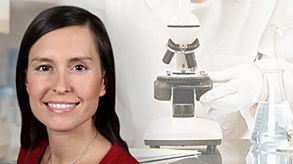Dr. Tamara Zietek describes her work studying intestinal nutrient absorption with organoids
Studying Intestinal Nutrient Absorption with Organoids

Dr. Zietek obtained her PhD at the University of Cologne, Germany. She is currently a principal investigator in the Nutritional Physiology laboratory at the Technical University of Munich. Her lab is focused on studies involving intestinal nutrient transport, nutrient sensing and incretin hormone secretion in the context of target identification for diabetes therapy.
The Scientist
Do you have a scientific idol that influenced the scientific path you’ve chosen?
My scientific path was influenced by both Professor Fiona Gribble of the Metabolic Research Laboratories at the University of Cambridge, UK and Professor Hans Clevers from the University Medical Center in Utrecht, Netherlands.
What led you to studies in your current field?
My group is currently working on intestinal nutrient transport and sensing. I have always been interested in nutrition and biochemistry. During my PhD in Cologne I worked on a project studying functional food. Afterwards I started work in Munich as a Principal Investigator studying molecular nutrition and intestinal nutrient transporters in mammals.
What hobbies do you have outside of the lab?
I enjoy pilates, zumba, hiking and travelling.
The Science
Please describe the focus of your current research.
My current research focuses on intestinal nutrient and drug absorption, as well as the role of intestinal transporters in nutrient sensing and incretin hormone secretion. My current projects focus mainly on intestinal sugar and peptide transporters and on intestinal absorption of novel peptidomimetics as candidates for cancer therapy and diagnosis.
What do you consider to be the most important advance(s) in intestinal research in the last five years?
I think growing intestinal organoids has revolutionized intestinal research. It has brought us new insights into enterocyte differentiation and valuable advances in intestinal stem cell research. It has enabled personalized drug screenings for cancer therapy and in vitro correction of genetic mutations of diseased patients (e.g. cystic fibrosis). The first approaches for transplantation in animals are impressive and promising.
As well, the discovery of compounds that are capable of increasing the number of GLP-1 producing enteroendocrine cells in the intestine is a highly relevant finding for incretin-based diabetes therapy.
What breakthroughs would you anticipate in the next five years?
I would expect to see the commercialization of personalized cancer therapy using tumor organoids, the establishment of organoid biobanks, transplantation of patient-derived genetically corrected organoids in animals and maybe the first approaches for transplantation in humans, or new approaches for diabetes therapy based on incretin hormones targeting enteroendocrine cells.
What has the adoption of organoid cultures added to your research? What types of biological questions has this technique enabled you to probe?
The organoid technology has provided an excellent in vitro model to study functional and molecular processes in the intestine of wild type and transporter knockout mice. It is the first in vitro model that allows us to study intestinal transport (absorptive enterocytes), gut hormone secretion (enteroendocrine cells) and intracellular signaling (all intestinal epithelial cells). Organoids represent a valuable tool for our research on intestinal nutrient transport, sensing and incretin hormone secretion. The generation of organoids from knockout mice is a fast and reliable method to generate an intestinal knockout culture with 100% gene knockout and no off-target effects. This enables the identification of intestinal transporters that are involved in gut hormone secretion or responsible for transport of a certain substrate. Furthermore, we can study changes in intestinal morphology caused by a gene knockout by observing the growth of organoids.
What impact do you see organoids having on the intestinal field? What technical hurdles remain before this can be realised?
I think organoids will improve studies of the molecular basis of diseases such as cancer, inflammatory diseases, genetic/hereditary diseases, and provide a model for personalized drug screening such as cancer therapy.
I can think of a few hurdles that will challenge the progress of these advances, for instance: cultivation is still expensive; when working with human organoids, access to tissue sources and ethical issues can pose limitations; there is high variability between organoid cultures from different donors caused by natural inter-individual variability of human subjects. In addition, we have yet to establish a suitable control or “gold standard” for organoid culture. This would require a large-scale comparison of experimental outcomes between different laboratories worldwide.
Featured publications:
- Zietek T et al. (2015) Intestinal Organoids for Assessing Nutrient Transport, Sensing and Incretin Secretion. Sci Rep 5:16831.
- Zietek T & Daniel H. (2015) Intestinal nutrient sensing and blood glucose control. Curr Opin Clin Nutr Metab Care 18(4):381-8.
- Daniel H & Zietek T. (2015) Taste and move: glucose and peptide transporters in the gastrointestinal tract. Exp Physiol 100(12):1441-50.
Request Pricing
Thank you for your interest in this product. Please provide us with your contact information and your local representative will contact you with a customized quote. Where appropriate, they can also assist you with a(n):
Estimated delivery time for your area
Product sample or exclusive offer
In-lab demonstration


